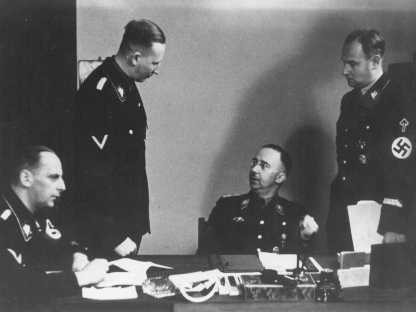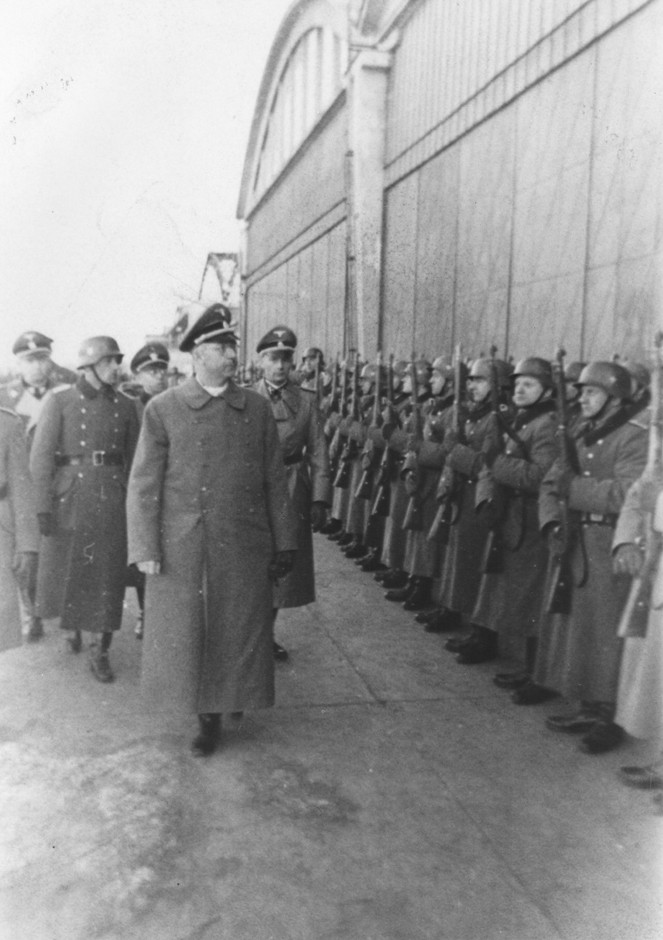
SS and Police
Combining the SS and the police into one institution was an important step in the Nazi regime’s transformation into a powerful dictatorship. This SS and police system had the ideological radicalism of the SS and the executive authority of the police. During World War II, SS and police leaders were responsible for perpetrating the mass murder of Europe’s Jews.
Key Facts
-
1
During the 1930s, SS Chief Heinrich Himmler took control of and centralized Germany’s police organizations.
-
2
Combining the SS and police meant combining an ideological Nazi Party organization with the civil service. By 1939, almost all police leadership positions were held by SS officers.
-
3
This SS and police system was key to implementing the Nazi regime’s radical plans. It was responsible for numerous Nazi crimes, including the mass murder of Europe’s Jews.
Introduction

When the Nazis came to power in 1933, they did not have a detailed plan for Germany’s decentralized uniformed, criminal, and political police forces. But by the beginning of World War II in September 1939, this had changed. SS Chief Heinrich Himmler had taken control of and centralized Germany’s police organizations. Part of the Nazi Party, the SS (Schutzstaffel, Protection Squadron) was an elite paramilitary organization. It was divided into distinct units. One of these units is the most important to understanding the relationship between the SS and the police. This unit was the SS intelligence service called Sicherheitsdienst (literally, Security Service, often called the SD).
Himmler intended to combine the SS and the German police into a new “state protection corps” (Staatschutzkorps). He wanted to create an SS and police system. Himmler’s goal was to turn this system into an effective weapon for the Nazi regime. He also aimed to turn it into a stronger power base for himself. Himmler planned to use the executive authority of the police to implement the SS interpretation of Nazi ideology. Together, the SS and police would be responsible for crushing political opposition. They would also be responsible for eliminating racial, social, and criminal enemies, especially Communists and Jews.
During World War II, Himmler planned to implement massive demographic changes. He intended this effort to provide Germans with “living space” (Lebensraum). The SS and police were tasked with carrying out measures to meet this goal. They were responsible for the expulsion and enslavement of Poles, Russians, and other Slavic peoples. They were also tasked with the elimination of Jews.
Centralizing the Police

Over the course of the 1930s, Himmler gradually took control of and centralized the police. An important milestone in this effort came on June 17, 1936. Adolf Hitler appointed Himmler as the chief of the German police (Chef der Deutschen Polizei). From that point forward, Himmler officially controlled all SS forces and all police forces in Germany. However, the SS and the police were not officially united in 1936. Rather, as Reichsführer SS and Chief of the German Police, Himmler personally embodied this connection.
Himmler created two new police “main offices” in June 1936. This measure further institutionalized the SS-police relationship. The use of the phrase “main office” was typical for SS administrative structures. It signaled that these organizations belonged with the SS, in spirit if not by law.
The Main Office of the Security Police (Hauptamt Sicherheitspolizei, SiPo) was under Himmler’s deputy Reinhard Heydrich. It included the Kripo (criminal police) and the political police or Gestapo (officially called the Secret State Police). Heydrich was also the chief of the SS intelligence service (SD). Himmler and Heydrich hoped to combine the SD and the Security Police into one organization. This connection was further secured after the invasion of Poland and the start of World War II on September 1, 1939. On September 27, Himmler created the Reich Security Main Office (Reichssicherheitshauptamt, RSHA). The RSHA officially combined the Main Office of the Security Police with the SD.
By 1939, virtually all police leadership posts were held by SS officers. But many lower-ranking policemen did not join the SS. Himmler never succeeded in completely merging the SS with the police.
Consolidating Power
The SS and police system competed with the military, the civil service, the Nazi Party, and others to win Hitler’s favor. SS and police leaders Himmler, Heydrich, and Kurt Daluege attempted to create administrative structures that would expand and secure their power and the power of the SS and police system. This meant staking their claim. Wherever possible, it also meant removing police forces from the control of other government ministries and party leaders. They wanted SS and police forces to answer directly and only to the SS hierarchy.

In practice, the three men created a confusing administrative system. The system had overlapping jurisdictions and unclear hierarchies. Exactly which SS and police official was most powerful in any given region of Germany or Nazi-occupied Europe depended on timing, personality, and skill. It also often depended on personal relationships.
Reinforcing Centralization and SS Control
The new main office system shaped the administration of police at the local and regional level. In 1936, Heydrich and Daluege appointed two types of regional representatives:
- Inspectors of Security Police and SD (Inspekteur der Sicherheitspolizei und des SD, IdS) oversaw all Security Police and SD units in a given region. The IdS would supervise multiple Gestapo, Kripo, and SD offices.
- Inspectors of the Order Police (Inspekteur der Ordnungspolizei, IdO) oversaw the Order Police units.
Typically, the men appointed to these positions were long-time, high-ranking SS men. Their job was to guarantee that the police units worked within the new SS and police hierarchy. The inspectors served as liaisons between the local police forces and the main office in Berlin. They were also supposed to represent the SS and police system at the regional level with regional leaders from other organizations.
The IdS and the IdO expanded and changed after the start of World War II. In occupied territory, the IdS and the IdO had new names:
- The IdS became Commanders of Security Police and SD (called in German Befehlshaber der Sicherheitspolizei und des SD, BdS). They commanded all personnel and units of the Security Police and SD in their assigned region.
- The IdO became Commanders of the Order Police (called in German Befehlshaber der Ordnungspolizei, BdO). They commanded all of the personnel and units of the Order Police where they were assigned.
As Heydrich and Daluege's representatives, these positions had a great deal of power. They were an important force for implementing the Nazi regime’s radical plans.
Higher SS and Police Leaders

In 1937, Himmler created a new SS and police position. It was called Higher SS and Police Leader (Höhere SS- und Polizeiführer, HSSPF). In each military district (Wehrkreis), an HSSPF would represent all interests of the SS and police. This included the Security Police, the SD, and the Order Police. It also represented the interests of non-police organizations such as the Waffen-SS.
The HSSPFs were part of the merging of the SS and police. As such, they held both an SS and a police rank. Most often they held the ranks SS lieutenant general and general of the police (SS Obergruppenführer und General der Polizei). These committed SS leaders answered directly to Himmler. They often had subordinates called SS and Police Leaders (SS- und Polizeiführer-SSPF).
At the time of the position’s creation, there were thirteen military districts. Thus, there were thirteen HSSPFs. The men who became HSSPFs shared an ideological worldview and background. Many of them had served in World War I and then continued fighting after 1918 as part of right-wing paramilitaries. They were early members of the SS and committed Nazis.
At first the HSSPFs in Germany had very little actual power. However, the numbers and power of the HSSPFs grew as Nazi Germany expanded right before and during World War II. At the peak of Nazi administration, there were at least 35 HSSPFs who oversaw large areas.
Higher SS and Police Leaders of the Holocaust
The centralization of the SS and police—in particular the role of Higher SS and Police Leaders—is key to understanding the Holocaust.
The radical men who held HSSPF positions oversaw all SS and police units in their area of operation. These included Einsatzgruppen, Order Police Battalions, Gestapo Offices, auxiliary police units, and Waffen-SS units. The HSSPF also had close ties to Himmler, and thus to Hitler. As Nazi policy radicalized to mass murder, the HSSPFs often led the way.
In June 1941, the German-Soviet war began. It was an HSSPF who coordinated many of the mass shootings perpetrated by the Einsatzgruppen and Order Police Battalions. An HSSPF also organized several infamous massacres. These included the massacre at Kamenets-Podolsk on August 27–28 and at Babi Yar on September 29–30, 1941. Also organized by an HSSPF was the Rumbula massacre on November 30 and December 8–9. At least 25,000 Jews were forced from the Riga ghetto into the Rumbula Forest, where they were killed.
Critical Thinking Questions
- Research what pressures and motivations might have influenced members of the SS.
- In what ways did the SS coordinate the activities of German and foreign police agencies to persecute perceived "enemies of the state"?

